The first new Bowler since 2016’s Bulldog will be a rapid road-going remix of the old Defender. Hand-made by Bowler in Belper, it’s code-named CSP 575. That’s CSP, as in Cross Sector Platform, and 575, as in the output in metric horsepower of the 5.0-litre supercharged V8 that powers it.
It’s the first Bowler developed since Land Rover’s SVO division assumed control, so of course it uses the shape of the Defender 110 Station Wagon with JLR’s complete blessing. There’s a point being made here, after Ineos found itself having to persuade a court that its Grenadier was sufficiently different from the old Defender.
Here, it’s not just a resemblance: the aluminium body panels are the same as those used in the last-generation 110, which went out of production in 2016. That’s a complete contrast to the Bowler Bulldog, which doesn’t have any Defender parts.
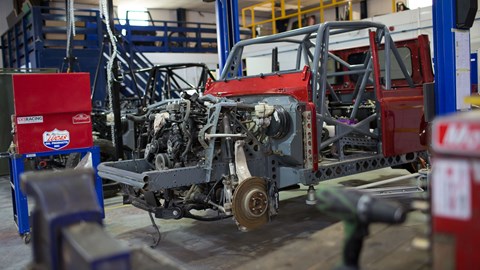
Inside, there are four sports seats and a rollcage. There’s air-con, but not many of the comfort, convenience or infotainment features that form part of 2020’s new-generation Defender. This is a much more hardcore and road-focused creation, with 567bhp and all-wheel drive promising ferocious acceleration.
The order books open early in 2021, when limited production will begin in right-hand drive, with the UK and Ireland the first target. Expect to pay around £200,000.
It will be in addition to Bowler’s core rally raid activities, not instead of. And if it serves as a British-made spoiler to 2022’s French-made Ineos Grenadier, then that suits JLR just fine.
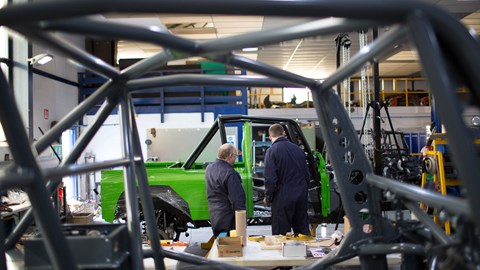
The Bowler Bulldog needs a bit more explaining than the CSP 575. At first glance the Bulldog is just a modded Land Rover Defender: stripped down, jacked up, toughened and tuned. In fact it’s not a Defender at all, although clearly that was the starting point for the whole Bowler project 30-odd years ago.
It all began with Drew Bowler – desert racer and engineer – creating the Defender-based Tomcat, then the Wildcat, and evolved into a company that makes, modifies and maintains 4x4s for serious off-roading, especially desert racing. It had been run from the Bowler family farm in Haxelwood, but in 2014 moved to a modest light-industrial unit in nearby Belper.
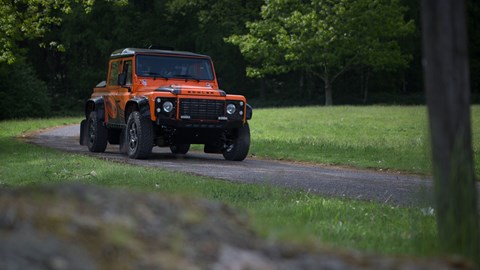
And then in November 2016 Drew Bowler died. They paused for breath, then carried on. And in fact the first person to talk me around the Bulldog is Drew’s son Sam, an electronics engineer. We’re in the factory in Belper. It’s also the service centre, the race-prep workshop, the showroom, the visitor centre, everything.
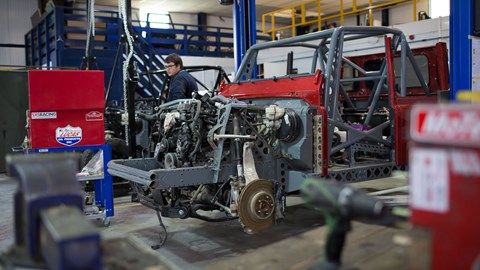
Bowler was bought at the end of 2019 by Land Rover’s Special Vehicle Operations division, but has remained based in the Belper factory (although some testing and development work is done at SVO premises). It’s not a factory in the Toyota sense. It’s a massive shed, well equipped with laser cutters, metal-folding machines and welding bays. What goes on here is more than simply assembling the cars, less that building them from iron ore.
Parts arrive in various degress of completion, and here they’re lovingly crafted into cars, no two the same, at the rate of 25-30 a year, with about 33 staff; the factory could stretch to about 50 a year. Prices start around £135,000.
All the cut sheet metal parts – chassis components, some body parts – are manufactured here from base materials; that’s where Bowler’s renowned precision fabrication comes in. They buy engines, transmissions, subframes, diffs and some steering parts from JLR, and largely leave them alone.
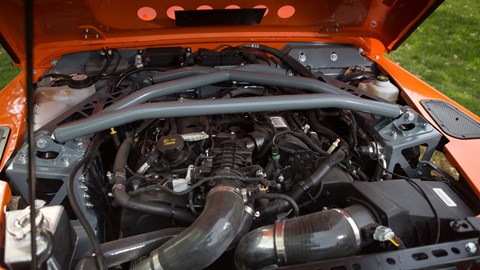
The engines currently used are a single-turbo V6 diesel (used in twin-turbo form in the Range Rover and Sport) with 280bhp and 443lb ft, which I’m about to drive, and a supercharged V6 petrol. In the pipeline there’s a supercharged V8 5.0 petrol. (Ford engines could also fit.) Both use Land Rover’s own engine management, and eight-speed ZF gearboxes.
There are no robots and few computers here. It’s a place for people who start with an interest in engineering and while here are trained and nurtured into becoming world-class makers and menders. They work studiously, calmly. They walk around the part-completed cars, like surgeons around an operating table. Surgeons, that is to say, with big wrenches and steel toe-capped boots: there are a lot of large metal components that would hurt like hell if you dropped them on your foot, not that we hear anything being dropped on our visit.
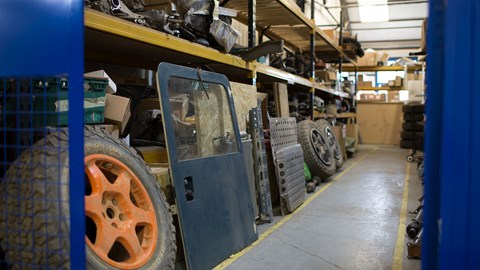
And there, pointing towards the exit, is the Bulldog I’ll be driving. It’s road legal, but it’s a race car. More road-orientated versions can also be made.
Sam Bowler shows me the Brembo brakes, the Bilstein shocks built to Bowler spec, the wheels from Compomotive Motorsport. He explains that the air duct/fan combo on the lightweight glassfibre roof is a transmission cooler: they found that when driving in sand, when the transmission is working hard but you’re getting minimal airflow, the transmission oil benefits from extra cooling. The yellow and red buttons are to isolate the battery.
The engine, transmission, diffs and some steering parts are from JLR, but they’re more Range Rover Sport than anything – there are no actual Defender bits. It’s Bowler’s own steel chassis and aluminium body. The side-exit exhaust is made specially for Bowler.
Inside, it’s a mix of familiar Land Rover bits and less familiar levers, buttons and switches. And a hammer to help you break the glass should you need to exit via the windscreen if you find your doors held shut by sand dunes.
At the wheel you have a lot of blanks where a Range Rover Sport owner would expect comfort-tweaking features, but also a lot of unfamiliar extras. The co-driver gets their own screen wash button, so the driver can stay focused. There are two ‘on’ buttons – one to fire up the fuel pump and other systems, the other to crank the engine.
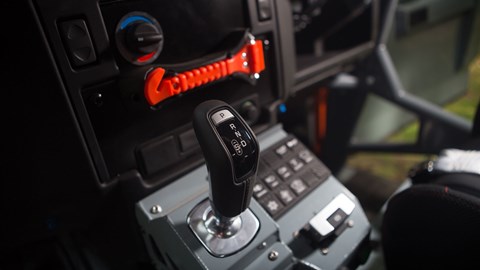
Sam tells me what I need to know if I’m to avoid embarrassment while I’m getting used to the Bulldog, which boils down to not making any sudden movements.
And then he waves me off for the 40-minute road drive from the factory to the test track. On the road, it’s all pretty straightforward as soon as you’ve adjusted to the lack of slack in the Bulldog. It’s very responsive, very loud, but sporty loud, not agricultural. The suspension is a delight – it does preciely enough to keep the wheels on the ground, and to isolate the driver from bumps.
He was right to warn me about the directness. If you press a pedal or turn the wheel, you need to be sure you mean it, because it will respond without hesitation. It’s raw. But it’s basically like any other car, in the way that a mouth stripped of all its teeth and gums, leaving only metal fillings, is like any other mouth.
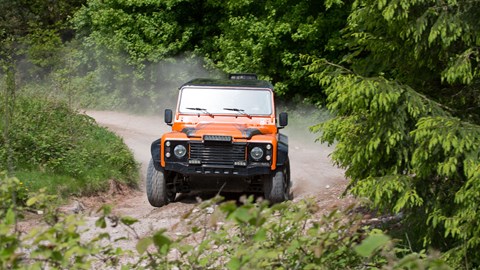
The test track is on a big country estate, and includes a variety of surfaced and unsurfaced layouts, but I’m here to use the dirt track. I’ll be doing it in a slightly different Bulldog, one in full race spec, so I get another briefing, this time from rally race veteran Mark Hawkins, with the focus on how unlike a road car it is, and how close to a desert racer. That’s because it is one; this very car was used by Alex Cole and Emma Osman when they won the 2018 Tuareg Rally.
The track car has built-in jacks for quick wheel changes, a spare-wheel holder for three wheels, extra underbody bash protection, bonnet-mounted LEDs for extra illumination after dark, sand mats (to go under the tyres if you get stuck) and sand shovels – the sort of thing you get in a £15,000 extras pack from Bowler.
Mark explains that I can change up and down manually, or leave one or both to the auto ’box. The pedals are set up for easy left-foot braking, with a footrest on the right to help you maintain a steady throttle opening without kangarooing along on rough surfaces. He says I need to be committed when I turn in, and get on the gas quickly out of bends. He explains this while driving me around for a couple of laps. He can’t help but make it look easy, but I’m not daft enough to think that my minimal off-road experience will allow me to drive it this smoothly and this quickly.
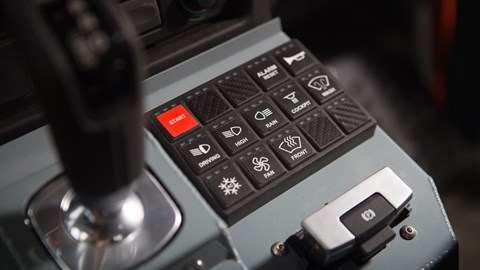
Off road, the Bulldog’s very flattering. Trust it and it will take care of you. Don’t fight it, but do point it exactly where you need it to be. The standard eight-speed ZF auto ’box is set in dynamic mode. Seems it’s best to make your own pre-corner downshifts with precision and benefit from the engine braking, but still let it make its own upshifts while you concentrate on steering.
It’s easy to make a lot of progress in a couple of two-minute laps, and to start believing that the talent I have in my fantasy life as Seb Loeb’s stand-in is actually real.
It isn’t. Mark is a cheerful, easygoing bloke who deals with customers and potential customers of all levels of experience and ability. You hear a lot of his simple catchphrase – ‘Turn in early. Feel it, feel it. Power on’ – but he goes a bit quiet momentarily after I over-compensate coming out of a bend and almost ram the car into a bank, instead clipping it, and achieve a sickening – but brief – lift-off on the right-hand side. We both know what’s happened, and we both know I’m not going to do that again; we also both know I’m never going to get the call from Loeb’s people.
Back at the factory, after an even more enjoyable reverse journey in the road car on the same roads, with my driving now more attuned to the Bowler’s simple, strong rhythms, I meet some more Bowler people to get the lowdown on the Cross Sector Platform. It’s a simple and very adaptable ladder-frame chassis with modular spaceframe attached, on which hang the engine, suspension and bodywork. The wheelbase can be changed.
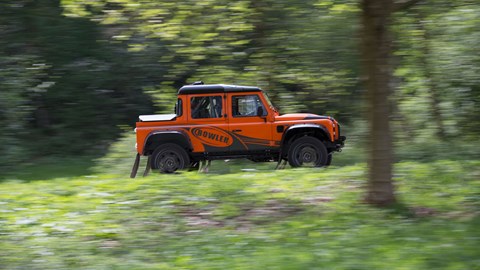
Different sub-systems can be fitted, making it a rally raid racer, an ambulance, a safari people carrier, a military reconnaissance vehicle, anything. It has independent suspension, mostly from the Range Rover Sport, but with the front lower arms replaced by one-piece wishbones, and the air suspension replaced by conventional springs, designed by Bowler with Eibach, and Bilstein dampers.
The Bulldog was developed in 2016 initially as a prototype and test vehicle for CSP. For now, the focus for Bowler’s 30-odd staff is making a couple of dozen new vehicles a year, and serving the needs of the hundreds of hard-bitten Bowler enthusiasts dotted around the world, all of whom they basically regard as mates. There’s also a programme of race support and preparation (for cars and drivers), and servicing and repair.
For Bowler, racing is both marketing and R&D. Bowlers never die; they just get repaired and upgraded. At any rally raid, anywhere in the world, there are likely to be dozens of Bowlers competing.
Not every Bowler gets raced in the desert, but they’re all bought by people who like to keep it raw, simple, direct. That’s not, to put it mildly, everyone’s cup of tea, or in everyone’s budget. As well as £135,000-plus, you need a vivid imagination, a head full of dreams, considerable driving talent and a bottle full of brave pills. It’s territory largely abandoned by just about everyone else, including Land Rover. Where Land Rovers are increasingly luxurious and digital, a Bowler’s chief ingredients are strength, lightness and power, all bound together by experience and an intense devotion to excellence.